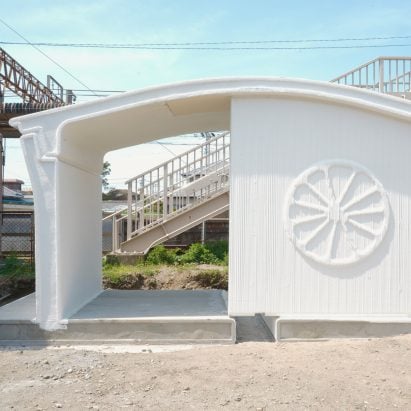Japanese company Serendix has completed what it claims is the world’s first 3D-printed railway station in Arida, Japan, which was constructed in the hours between the last and first train services.
Collaborating with JR West Japan Group and Japanese architecture studio Neuob, Serendix created a 3D-printed shelter with an arched roof for Hatsushima Station, which replaced a wooden structure built in 1948.
Serendix said its design is the “world’s first 3D-printed station building”. It was constructed from four elements that were 3D printed in a factory and assembled at Hatsushima Station in under six hours.
Serendix has 3D printed a shelter for Hatsushima Station
Station buildings and construction near railway lines are typically carried out at night when trains are not running, often leading to long construction timeframes.
At Hatsushima Station, Serendix constructed the shelter and its foundations in the six-hour time window between the last train service and the first service the next morning.
It was made from four prefabricated parts – a roof, a back wall, and two corner elements forming the side walls and floor – which were made in seven days in a factory.
It was constructed in under six hours
A robotic arm and nozzle 3D printed the shell of the four parts in a specially-designed mortar that dries faster than standard mortar. Rebar and concrete were then poured into the 3D-printed parts to increase their strength.
According to Serendix, the four elements were assembled on the train station site in around two hours. Metal rods were then inserted into fixing holes, and adhesive was added to secure the structure.
A mandarin orange relief features on the station’s exterior
The Hatsushima Station shelter measures 6.3 metres wide and 2.1 metres deep, and its arched roof reaches 2.6 metres tall.
Its back wall features a 3D-printed mandarin orange design on one side and a cutlassfish on the other, representing Arida’s popular produce.
“Rounded designs are costly and difficult to achieve with concrete construction using formwork,” Neuob founder Hiroshi Ota told Dezeen. “We chose curved, soft shapes to take advantage of this benefit.”
“Furthermore, to reflect local characteristics, we expressed the local specialities, mandarin oranges and cutlass fish, in relief, which is another feature uniquely possible with 3D printing.”
The station shelter is made up of four hollow elements that were filled with concrete
Serendix 3D printed the four elements vertically rather than horizontally, resulting in the buildup of printed layers creating a striped vertical pattern.
“While 3D printed architecture typically has horizontal layering, in this case, we conducted extensive technical studies to rotate the output 90 degrees after printing, resulting in vertical layering,” Serendix told Dezeen.
“This reduces the visibility of rain streaks and improves the building’s maintenance properties.”
The station will be open for use in July, following the completion of external works and the installation of ticket gates.
The 3D-printed parts were printed vertically
Serendix hopes to build more 3D-printed stations like Hatsushima Station in the future, claiming the short construction period offers an affordable way to build.
“Typically, building a station of the same size using reinforced concrete would take one to two months,” said Serendix.
“Additionally, in Japan, there is a notable shortage of workers in the construction industry, resulting in soaring labour costs and difficulties in securing construction personnel,” it continued.
“While the 3D-printed station is made of robust and durable concrete, the assembly of the structure was completed in just two hours – this speed enables more affordable and numerous station constructions.”
Earlier this year, construction technology company ICON completed a 3D-printed home in Texas and announced it is working on another 3D-printed housing development with Michael Hsu.
The photography is by Serendix and Neuob.
The post “World’s first” 3D-printed railway station built in Japan in six hours appeared first on Dezeen.
